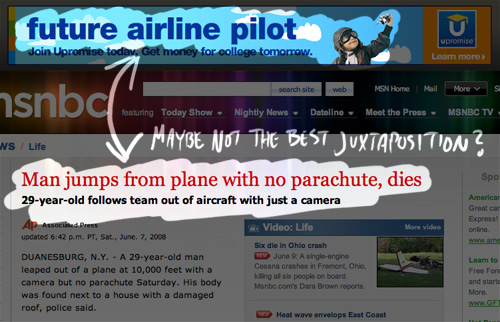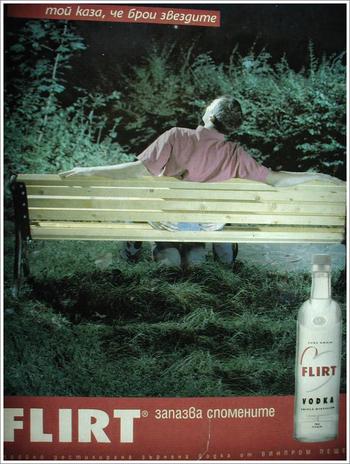Mike is doing some brainstorming on how to predict and cope with bandwidth spikes when a post or page suddenly becomes a popular destination.
When a blogger’s work becomes successful enough to, for a moment, graze the underbelly of commercial publishing, it threatens the very low-cost predicate of the publication itself.
>
Setting aside for the moment the absurdity of the situation, which is clear, it seems to me that over the past few years we’ve seen this exact phenomenon occur over and over again. I’m guessing, now that media people have integrated the blogosphere into their information gathering practices, we’ll see it with greater frequency and to more devastating effect over time.
 As I recently discovered, this is a very real worry. I’d joked in the past about the “perfect post”, that one blog entry that suddenly exposes a site to the world and brings in all the traffic that so many people wish that they had — but actually stumbling upon that “perfect post” has made it very clear just how much of a double-edged sword that can really be.
As I recently discovered, this is a very real worry. I’d joked in the past about the “perfect post”, that one blog entry that suddenly exposes a site to the world and brings in all the traffic that so many people wish that they had — but actually stumbling upon that “perfect post” has made it very clear just how much of a double-edged sword that can really be.
In Mike’s ruminations on how things like this can be coped with, he mentioned something that sounded like a possibility…
…I think there is a proactive business opportunity for the right business to defray these transient bandwidth costs, probably in the form of short term ads on the sites that are experiencing the bolus. […] I will note that it might even be cooler yet if this feature enabled Google keyword ads. Maybe it should be an independent service, or a program that the keyword service provides for bloggers, who are currently more or less specifically discouraged from using it.
I applied for Google AdSense at one point, but they turned me down. While it was a bit of a bummer, it wasn’t much of a surprise, as Google doesn’t seem to want to accept most weblogs into their AdSense program. It seems that if you run a very tightly-focused weblog on a specific topic (such as PVR Blog or Daring Fireball) you’ve got a good chance of being accepted, but less-focused weblogs (such as mine, yours, the one you’re going to read next, or the other 99% of the blogosphere) will be denied. Unfortunately, the exact methodology or reasoning behind the approval/denial process is more than a little unclear.
There’s a far more serious problem with AdSense, though. The approval system is capricious, even arbitrary. It’s understandable that Google wants to make sure sites aren’t just ad farms, and it’s in everyone’s interest that quality be maintained, ideally by human verifiers. Nobody wants to see those sad Red Cross PSAs that take the place of house ads on poorly-indexed sites.
>
The human verification process at Google, though, is uncharacteristically opaque. I’d assume they factor in the ads which would run on a site before approving or denying an application, and if I take a look at , I see some of value. Ads specifically targeted to weblog software, Manhattan computer repair, New York hotels. These all seem relevant and valuable to me, but I’ve been repeatedly rejected.
>
It’s not just sour grapes on my part. Take NYC Eats, a great little niche weblog. Aaron’s brilliant little AdSense senser shows , which makes sense since the letters “NYC” by themselves cost two dollars a click. But no AdSense approval there. The problem is the wording in theprogram policies:
>
In general, we do not accept personal pages, chat sites, or blogs into the AdSense program. However, if a site contains targeted, text-based content and/or provides a product or service, we may consider it for participation.
In a perfect world (well, my perfect world, that is), of course, Google would open up their AdSense program to the weblogging world at large. While their AdSense ads might be a little random on the main page of a site due to the random nature of the main page posts not giving clear, concise keywords to work with, if a site design includes individual archive pages than each individual post should have enough keywords to target a specific ad category (my Mac-specific posts would get Mac-centric ads, my political posts would get political-centric ads, and so on).
If they don’t want to do that, though, what if Google set up an agreement with TypePad (or other for-pay hosting sites) in which, in order to offset the cost of bandwidth spikes, Google AdSense ads could be (semi-)automatically added to a site when they reached a certain bandwidth point (90% of their available monthly bandwidth per their agreement, for example)? Each auto-generated template could include code something along the lines of <$MTAdSense><!-- include "/ads/google/adsense.inc" --><$/MTAdSense$> that would be automatically triggered by the TypePad servers when bandwidth exceeded whatever the cutoff point was. Any revenue generated by clicks on the ads would automatically be siphoned to TypePad and applied to offset the costs of the extra bandwidth usage during the spike.
There could even be a toggle in the TypePad preferences that allowed a site author to insert a “registration key” if they were accepted by the Google AdSense program that would enable the AdSense ads on a full-time basis. In this case, Google would send any revenue to the site author as per their usual setup, instead of sending it to TypePad.
Just an idea. Workable? I haven’t got a clue — barriers include the coding of the feature (while I’m no program-level coder, it doesn’t strike me as being too terribly difficult of a feature to enable), inclusion of the feature into already-existing weblogs (not difficult for TypePad Basic, Plus, or Pro levels using the auto-generated templates, Pro levels using advanced templates would need to add the requisite code themselves), and — most importantly (and possibly most difficult) — Google and TypePad (or, of course, whatever other hosting service that might be interested) negotiating the partnership. Still, if it could be worked out, I think it could be useful and beneficial to the blogging community at large.


